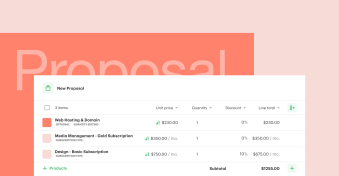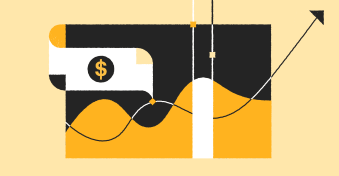Sales velocity is a robust metric used by sales managers for good reason.
It presents a snapshot of how your entire sales process is performing.
This guide will explain the sales velocity formula and what it means for your business.
Key takeaways
- Sales velocity measures the rate at which your sales force generates revenue.
- The four factors of sales velocity are number of opportunities, average deal value, win rate, and sales cycle length.
- Analyzing your sales velocity helps identify pipeline bottlenecks and areas for improvement.
- Sales enablement tools like CRM platforms help increase sales velocity.
- Document workflow software like PandaDoc increases close rates and shortens sales cycle lengths.
What is sales velocity?
Sales velocity is a KPI that indicates the rate at which your team generates revenue.
It gives a summary of how healthy your sales pipeline is over time.
Higher sales velocity means your business is operating efficiently and effectively.
Sales velocity is also known as pipeline velocity. So what does sales velocity mean?
Well, the higher the value, the more money your business generates due to a combination of variables.
Pipeline velocity is a comprehensive metric that monitors four primary sales factors.
Let’s look at the elements that make up the sales velocity definition.
Number of opportunities
Sales velocity opportunities do not equal the total number of leads.
Opportunities are those prospects that have been qualified by your sales team.
Qualified leads meet criteria such as having the budget or buying authority for your product or service.
More opportunities don’t necessarily mean a higher sales velocity.
The key is to increase the number of qualified prospects in your sales pipeline.
Average deal value
Another variable that affects sales velocity is the average deal value. Not every transaction is created equal.
You may be in several markets and have many target audiences. The average deal value affects your ideal sales cycle length.
Businesses that work on a subscription basis may prefer average customer lifetime value (CLV) instead of average deal value.
For these services, CLV paints a more accurate picture of daily expected revenue.
Win rate
Win rate is the percentage of opportunities that your sales team converts. The higher the conversion rate, the higher the sales velocity.
Win rate paints a picture of how well the sales team is performing. It may also indicate the health of your prospecting pipeline and lead qualification.
For example, a win rate of 5% likely means your team is spending time on poor prospects.
Average sales cycle length
Sales cycle length is the entire time it takes a lead to move through the sales funnel to conversion.
Your sales cycle length directly affects the velocity of your pipeline.
The longer it takes for prospects to convert, the lower the revenue you generate per day.
However, a fine balance exists between an efficient sales process and a rushed one with low win rates.
Why is sales velocity important?
Sales velocity monitors the overall performance of your sales process.
You need to know how quickly your team generates revenue to better plan and strategize for the business.
Sales velocity also produces insights that lead to improvement and optimization.
Here are some benefits of tracking sales velocity.
Eliminating bottlenecks
Sales velocity identifies lagging funnel stages that cause long sales cycles. Reduce or remove these to build optimal timings with higher win rates.
For example, sales order automation capabilities with PandaDoc include eSignatures and payment processing.
More time for high-value opportunities
Identify where your sales team should focus most of its time.
This leads to better win rates, increased average deal value, and greater revenue.
Sales forecasting
Gives you more accurate forecasts that inform better planning and decision-making.
Continuous performance monitoring
Metrics updated daily for real-time monitoring.
Managers are instantly alerted when sales are trending downward.
How to use the sales velocity formula: a simple guide
Okay, so definitions are fine and dandy.
It’s time to learn how to calculate sales velocity. Let’s take a look at the sales velocity equation.

Once you have a good grasp of the four factors, the sales velocity calculation is simple enough. All you need to do is plug in the data and work out the formula.
The higher the velocity, the better. Revenue improvement happens when you identify which of the four factors can be improved.
There is more to using the sale velocity formula than simply calculating a number. The first thing to consider is that it is a metric used over time.
Use sales velocity to track monthly, quarterly, and annual sales. Each value will give different insight and information.
Likewise, you can calculate sales velocity for different teams, products, regions, and markets.
You may find out that you need to speed up the pace of deals for SMBs, while a longer sales cycle is optimal for enterprises.
Sales velocity can also measure the performance of teams and individuals. This informs coaching strategies and performance.
A low sales velocity can even indicate that you need more salespeople to speed up the flow of your pipeline.
Remember that sales velocity is a comprehensive measure of how quickly you generate revenue.
It’s a useful tool that shines a spotlight on what’s working and what’s broken.
Managers and stakeholders should use these insights to improve strategies.
What is an example of sales velocity?
Let’s look at an example of sales velocity in the real world.
A SaaS provider sells document workflow software for businesses of all sizes. In the past six months, the prospecting team has qualified 100 leads.
Qualified leads are nudged further down the funnel to sales executives and closers.
As this is a subscription-based business, we will look at CLV. For this company, CLV is $5,000.
The company has recently implemented AI for sales enablement.
Thanks to automation and better insights, the team has a win rate of 40%. However, the sales cycle takes 50 days on average during the six months.
We now have all the data we need to calculate sales velocity for the SaaS company.
- Opportunities = 100
- Average deal value (CLV) = $5,000
- Win rate = 40%
- Sales cycle length= 50 days
Sales Velocity = 100 x $5,000 x 40% = 50 Days
The sales velocity of a SaaS company equals $4000 per day.
The business can use that number as a baseline for sales forecasting, budget planning, and other strategies.
What is a good sales velocity?
A “good” sales velocity is not some magic number.
What’s good for one business may be dire for another. Sales velocity varies by industry, region, business model, and other variables.
Why is this?
The answer becomes quite obvious when we examine the four factors of sales velocity.
Every industry, product type, and business model will have different needs regarding things like pricing and win rates.
For example, one study found that the average B2B sales cycle length was roughly 63 days.
For SaaS companies, this number jumps up to about 75 days.
B2C sales cycle lengths are much shorter, taking days or weeks.
At the same time, the average deal value in B2C industries such as retail and ecommerce is much lower than that of B2B.
This means that a good sales velocity for a small fashion business could be $500 per day.
On the other hand, a B2B service provider may have an industry benchmark of $5000 per day or higher.
How to increase sales velocity: best practices
No matter what your sales velocity is today, you want it to go higher.
Here are some ways to improve sales velocity for your business.
Increase your opportunities
Lead generation is the beating heart of your sales pipeline.
More importantly, quality leads drive the ceiling of your revenue generation.
The more opportunities for your sales team, the more potential for conversions.
First off, are you reaching your audience on their preferred channels?
In other words, where do they spend their time? Some customers prefer emails, while others prefer live chat or phone calls.
An omnichannel approach to marketing and lead generation assures you can widen your net. There are many benefits of marketing automation, including increasing lead generation.
You can use AI chatbots to offer 24/7 sales support on your website.
Use marketing analytics tools to identify which channels are most effective.
This will help you optimize your marketing budget and ad spending.
Increase deal values
Generating more money per deal is another way to increase sales velocity. Of course, you can’t just raise prices across the board in hopes of accomplishing more revenue.
Instead, you want your teams to gain a deeper understanding of your products and how they meet customer needs.
Tailor each step of the journey with bespoke offerings and suggestions.
Coach your sales team to understand how to build bundles and package deals when appropriate.
Create premium deals that offer value to the customer and bring in more revenue.
Additionally, sales training should focus on upselling and cross-selling opportunities.
Closers should remember to pitch things like warranties and other aftercare for purchases.
Boost conversion rates
Low conversion rates can be the result of several things. A common issue is that your team is getting inundated with low-quality leads.
Alternatively, they may get the best leads but lack handling and closing tactics.
For the former, there are many ways in which you can increase lead quality. Develop ideal customer profiles (ICPs) for each of your products.
Implement qualifying criteria with lead-generation tools that streamline lead scoring and grading. The goal is to have your team focus their efforts on leads with the greatest potential.
If your team is struggling to close, that’s a different issue. Sales managers will need to develop training programs for handling objections and closing.
One-to-one coaching and roleplay sessions are a great way to boost your team’s performance.
Equip your team with resources like pitch decks and playbooks that give them flexibility and guidance for each prospect.
Shorten the sales cycle
The faster you close a deal, the faster you can start working on another one.
Different stages of the sales pipeline have varying amounts of fat to trim around the edges. In most cases, bigger purchases have longer buying cycles. Inversely, smaller transactions necessitate shorter buying cycles.
This makes sense because customers will spend more time on research.
There also may be more gatekeepers and stakeholders involved in the decision process.
Logic follows that if you sell more per deal, you can take more time with prospects.
However, there’s always room for improvement, no matter how big or small.
You can qualify leads quicker with lead scoring tools. Apps automatically grade prospects from website and email interactions.
At the same time, qualified leads are better prepared for a shorter buying cycle. It all boils down to a higher sales velocity.
Develop well-defined buyer personas as part of your sales strategy.
These ready-made materials help your team to quickly identify pain points and objections. Buyer personas also help your team understand what’s needed to close deals.
For example, a CMO is ready to buy. A marketing lead may need to bring in a decision-maker or consult with a gatekeeper.
Sales automation tools and document workflow software streamline administrative tasks. Contract templates and eSignatures help optimize your sales cycle for a higher velocity.
Track the right periods
When it comes to data, bigger sample sizes are better. However, you don’t usually need to know the average sales velocity for the past five years.
Good milestones to use are quarterly, bi-annually, and annually. You want a good idea of how effectively your current sales process performs.
Don’t focus on short durations that cause you to panic when you have a bad week.
Keep terms and variables consistent
Variables like deal value and opportunities must stay consistent. If you use average deal value, don’t switch to lifetime value.
Don’t change up your definition of “new opportunities” mid-implementation. Doing this will artificially inflate win rates.
Monitor the competition
It can be difficult to get exact financials for many of your competitors. Have your team monitor the market leaders and use them as benchmarks.
If their sales cycle is shorter or their win rate is higher, you can do better. Use benchmarking to motivate your team to find new ways to improve sales velocity.
Boost your sales velocity with streamlined workflows from PandaDoc
Sales velocity is crucial to monitoring the growth potential of your business.
Once you have your baseline, you want to improve the performance of your pipeline.
Use PandaDoc to streamline your document workflows and pick up the sales pace.
Agreements and sales contracts are a cinch with our document workflow software.
Just create a template that fits your needs — even better, use one of our many templates!
Once you have an opportunity to move down the funnel, time is of the essence. Use our platform for centralized document management.
Send important pamphlets like a comparative analysis or spec sheet to prospective clients with just a few clicks.
When it comes to closing, you can strike while the iron is hot with legally binding eSignatures.
You can also collect payment instantly, increasing your close rates by up to 36%!
So, what are you waiting for? Start a 14-day trial today and learn what PandaDoc can do for you!
Frequently asked questions
-
No. Sales velocity and sales conversion rate are related metrics but measure different things. Sales velocity measures the rate at which your sales pipeline generates revenue.
Sales conversion rate measures the percentage of prospects that take a desired action within your sales funnel. This could be anything from signing up for a sales email to purchasing. Sales conversion contributes to your win rate, which directly correlates with sales velocity. The more sales you convert, the higher the sales velocity.
-
Technology is the backbone of any sales velocity strategy. CRM platforms automate administrative tasks and give your team access to customer information. Lead generation apps automate lead qualification and lead scoring.
AI tools such as chatbots help generate leads from websites and social media. Document workflow software like PandaDoc streamlines deals closing for shorter sales cycle lengths.
-
Sales velocity doesn’t always consider customer retention. The revenue generated is normally based on the average deal value. However, subscription-based businesses often use customer lifetime value instead of average deal value.
By using the sales velocity formula in this way, businesses can account for the value of customer retention. It is up to each organization to decide how to best define sales velocity for itself.
Disclaimer
PandaDoc is not a law firm, or a substitute for an attorney or law firm. This page is not intended to and does not provide legal advice. Should you have legal questions on the validity of e-signatures or digital signatures and the enforceability thereof, please consult with an attorney or law firm. Use of PandaDoc services are governed by our Terms of Use and Privacy Policy.


